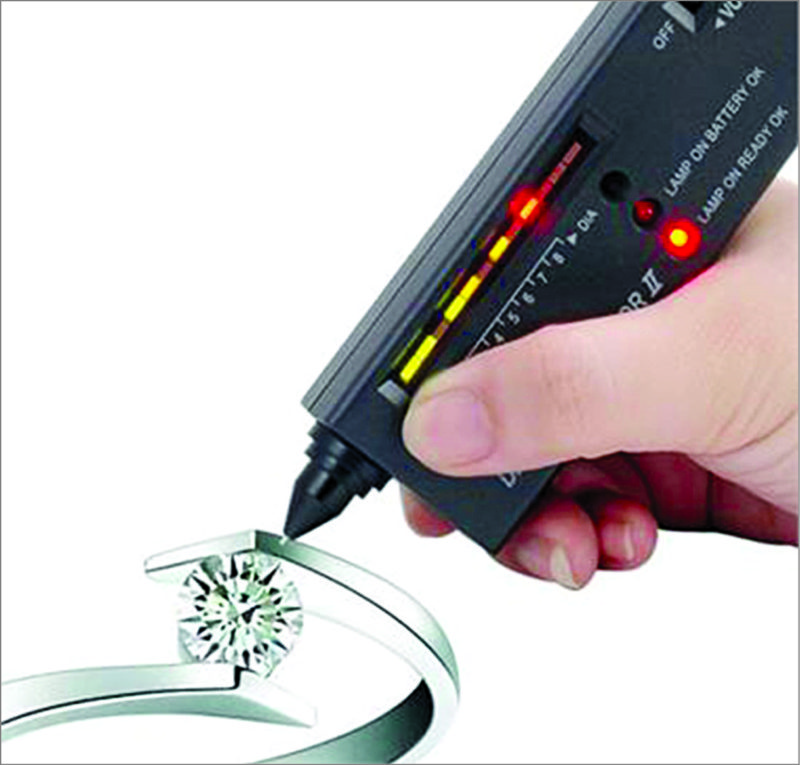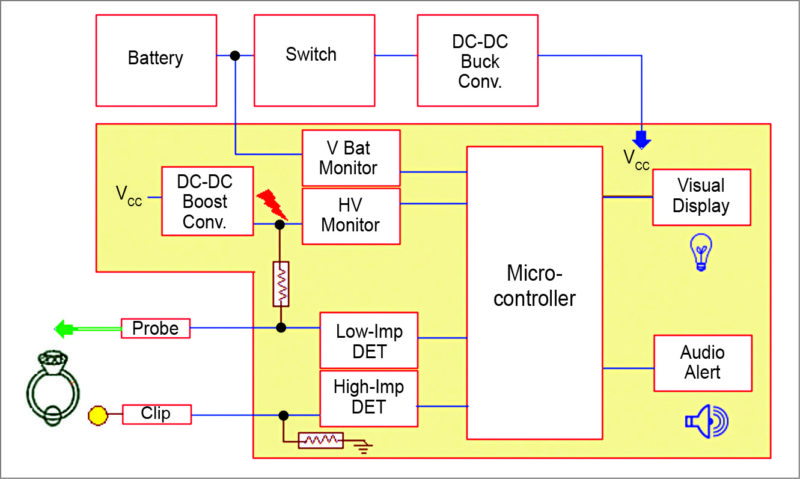Gemstone identification can be an arduous problem, and getting it right is essential for the people in the trade. Recently, electronic gem testers have come in the market that promise to simplify this problem. These are small, handheld devices with a small probe that is placed against the gemstone.
These devices first entered the market as diamond testers, and helped solve the problem of distinguishing natural diamond from cubic zirconia (a synthetic diamond stimulant). An electronic diamond tester is, in fact, a portable device that we can put in our pocket. The tester has a small, needlelike tip that needs to be placed firmly on the stone under test. If the diamond is real, the device indicates that on its display, often with an aural alert.

How it works
Diamond is an extremely good conductor of heat, and this property has been the basis of one of the oldest tests for diamond—touch a diamond with your lip and it will feel cold! Diamond testers’ working principle is based on the fact that different gemstones conduct heat differently. Heat will pass through a diamond in a different way than it would through a cubic zirconia or glass. The diamond tester will detect the rate at which heat moves through the stone and tell whether it is a real diamond or not.
As diamond is an exceptional thermal conductor (and cubic zirconia is not), the first diamond testers used a heated probe to detect heat dissipation. These were very effective at distinguishing natural diamond from cubic zirconia. But then another diamond simulant called moissanite entered the market, and diamond testers were not able to detect it (moissanite is also a very good thermal conductor).
Moissanite is a naturally-occurring mineral that was first discovered more than 100 years ago. At first glance, it looks very similar to diamond, and these two stones also seem to have the same physical properties. Although many people think of it as a substitute for diamond, moissanite’s chemical composition is quite different—diamond is made up of carbon, whereas moissanite is a form of silicon carbide.
This recant called for improved testers that use electrical conductivity to test stones. Latest diamond testers on the market include both thermal and electrical conductivity test modes. The advantage here is that you only need one device instead of two, and it costs slightly less to buy the two-in-one tester/multi-tester (heat for diamond and electricity for moissanite) rather than two separate testers.

Type II diamond tester.
Moissanite testers work by measuring electrical conductivity through the stone (diamond is not electrically-conductive, and moissanite is). However, there is a very rare type of diamond (type II diamond) that has an unusual chemical composition that makes it electrically conductive. So it will show as moissanite on a two-in-one tester/multi-tester. Fortunately, type II diamond testers are now available but cost a few extra bucks.
Role of UV light
Some diamond testers (Fig. 3) have a built-in ultraviolet (UV) light source, and this has led to the logical assumption that UV light can be used for testing diamonds. Note that, there is absolutely no way we can distinguish a diamond from a non-diamond using UV light.

UV light does, however, have some use for professional gemologists because it can give an indication of probability when comparing a natural diamond with a synthetic one. And, UV light makes a difference when testing a moissanite using a moissanite tester or two-in-one tester/multi-tester. Moissanite testers that do not work on some odd moissanites work perfectly when the stone is exposed to UV light. This is because, according to the laws of Quantum Physics, UV light can make a noticeable difference to electrical conductivity.
Gem tester electronics
Fig. 4 shows the reference system diagram of a gem tester that uses high voltage to quickly test a gemstone for legitimacy. This basic concept is adaptable for determining a gem type based on its electrical conductivity.

In principle, an electronic circuit (including the gem under test) as part of a circuit path is used to measure its electrical conductivity and, hence, the gem type. The procedure of determining whether a gem is moissanite or synthetic diamond involves providing a high voltage across a gem surface, greater than a breakdown voltage, and measuring a minuscule current that flows through the gem.
Here, the first (probe) and second (clip) contacts of the circuit couple the high voltage to the gem under test, while a low-impedance detector circuit is used to flag when the contacts are erroneously contacting each other during measurement. The amount of current flowing through the device is measured using a high-impedance resistor referenced to ground. Voltage on the resistor is measured and compared to a predetermined threshold voltage. Measurements above the threshold voltage indicate that the gem is conductive, and that the gem therefore is a synthetic diamond or moissanite.Conversely, measurements below a threshold voltage indicate that practically no current flows through the gem, and that the gem therefore may be a diamond—if other tests such as a thermal conductivity test show it to be as one.
At the brain of the gem tester is a microcontroller for processing a multitude of analogue inputs to produce a number of outputs for ensuring whether a measurement for a gem under test is, in fact, within a specific range, signaling that it is moissanite or synthetic diamond.
Getting the feel
Using a diamond tester/moissanite tester/multi-tester is not complicated. A good start is to read its user guide/instruction manual line by line, and make sure you are not doing anything wrong. If your tester works consistently (gives the same reading on the same stone every time) and correctly (accurately identifies stones), then you do not need to know the principle on which it works. However, if you are having problems, then the following basic tips will help solve most problems:
1. The probe of the tester must be clean, especially if it has not been used for some time. Clean it by rubbing it at right angle in a circular motion on a piece of white bond paper.
2. Clean the stone by wiping it with a clean cloth soaked in alcohol. Alcohol works best because it evaporates quickly and leaves no residue.
3. Place the tester probe on the stone at right angle, and press firmly to make good contact (hold the tip at right angle so as to not break it). You should get a result in about three seconds. If not, remove the probe, wait for a few seconds for the stone to cool down and try again.
4. Do not test the same stone repeatedly, until it becomes hot. Hot stones do not register as diamond, even if these are. (Inconsistent readings miraculously become consistent if you wait a minute or two for the stone to cool down.)
Further, relatively-cold stones give a high reaction on the LED indicator segments, and relatively-warm stones give a low and often sluggish reaction. (A very tiny diamond on a hot day may only move one or two LED segments up.)

A multi-tester can show you if the stone is a diamond or not. It carries out the diamond test and then, a fraction of a second later, it carries out the moissanite test. Its microcontroller combines both readings and calculates a response. You will not get correct readings if, in that first split second, you remove and replace the probe or slide it across the stone or press hard, then let go and again press hard. It only works if you put the probe in the centre of the stone firmly once. As with all testers, this is not a problem if you can see what you are doing and you have a steady hand.
An electronic diamond tester with state-of-the-art technology assures quick, accurate readings to determine if a diamond is real or fake. Most multi-testers utilise a combination of the proven thermal and electrical conductivity principles.
The tester probes, together with the electronics circuitries, are designed to pick up and segregate data collected from the stones via a customised microcontroller. Within a split second, the test result is displayed on an electronic display. However, no tester can offer 100 per cent guarantee of identifying all diamonds correctly. There are always exceptions, and these apply to almost all brands of electronic diamond testers.







